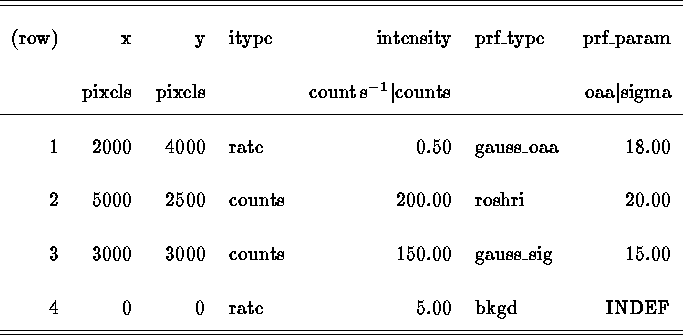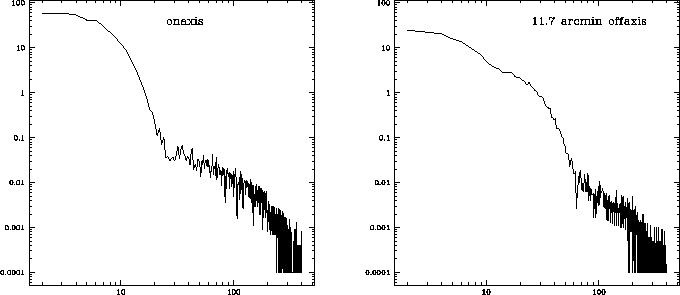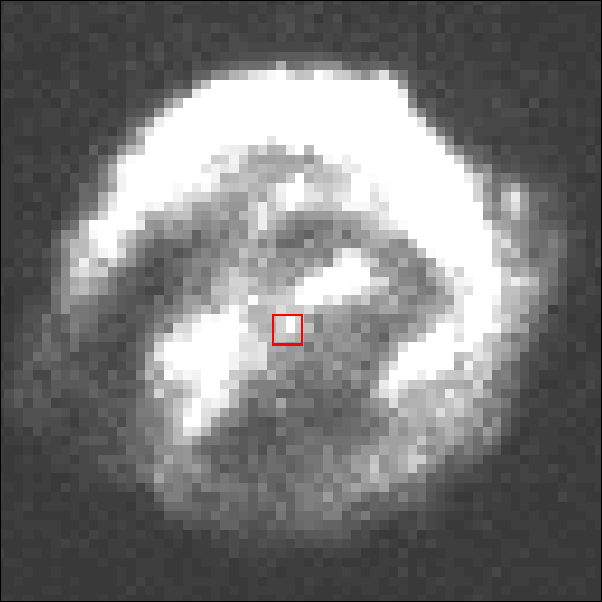
Table: Example of a qpsim source table
K. R. Manning, J. DePonte, and F. Primini
Smithsonian Astrophysical Observatory, 60 Garden St.,
Cambridge, MA 02138
Qpsim is a task which will simulate X-ray events for a ROSAT High Resolution Imager (HRI) observation in QPOE format. The task may be used to generate a random flat background as well as sources of a specific intensity, shape and position. The simulated data can be a useful tool in calibrating point source analysis software.
An STSDAS table file is used to describe the source and background data to be generated. Each row in the table represents information for a single source with the background treated as a special case. An example is shown in Table 1.

Table: Example of a qpsim source table
The desired intensity may be specified as either ``counts'' or ``rate.'' In the latter case, the user must provide a value for the livetime in order to calculate the source counts. The livetime value may be entered via a task parameter or extracted from a reference QPOE file.
The background data is designated by ``bkgd'' in the ``prf_type'' column. Two point-response functions (PRFs) are available for source data, either the ROSAT HRI PRF (described by David et al. 1993) or a Gaussian function. The ROSAT HRI PRF, designated ``roshri'', is described by an off-axis angle value. The Gaussian may be described by either a sigma value (``gauss_sig'') or by an off-axis angle (``gauss_oaa'') where the off-axis dependency of sigma is deduced from a 50% power radius assuming a Gaussian distribution (David et al. 1993, p. 17). Off-axis angle values are given in units of arc minutes, and sigma values in units of pixels.
Off-axis angle values are treated independently from source position, giving the user control over source shape. This allows the generation of identical sources at many positions in the field. Such fields can increase the efficiency of methods used to study simulated data and to calibrate source detection software. If an off-axis angle value of ``INDEF'' is given, the value will then be calculated from the source position.
All source positions are constrained to lie within the field size limits of an unrolled image. For the ROSAT HRI, this is taken to be the central region defined by the pixel range [2048:6144]. The exception to this is the background specification for which the table values of X, Y and ``prf_param'' are ignored.
Qpsim loops over the rows in the source table, generating the data for each source independently. The background ``source'' is treated as a special case, but the source data is generated with a general routine which invokes the appropriate PRF function. In this way, other PRF functions can be easily added to the program.
The IRAF system function ``urand'' is used to to select random, real numbers between 0.0 and 1.0. The X,Y coordinates of the background events are generated independently through a simple translation and scaling of random numbers:

If the resulting number is not within the field limits, a new random number is generated and the process repeats until a valid coordinate value is found.
Azimuthally averaged versions of the PRFs are used to generate source events. The distance of each event from the source center is determined by the solution of the integral equation:

for R. An angle is then randomly selected, and the projected  coordinates are calculated, so that we have:
coordinates are calculated, so that we have:

where  in equations (5) and (6) are the coordinates of the
source center. This method ensures that the events are uniformly distributed
over azimuth. The coordinates of the source events are then screened
to fall within the field limits, and the process is repeated until a valid
in equations (5) and (6) are the coordinates of the
source center. This method ensures that the events are uniformly distributed
over azimuth. The coordinates of the source events are then screened
to fall within the field limits, and the process is repeated until a valid
 pair is determined.
pair is determined.
The simulated data are output as an ASCII list representing events from all of the sources specified in the source table. The list is then converted to QPOE format with the IRAF/PROS tasks qpcreate and qpappend; at this point the user may select a real observation to which the events are appended.
Radial profiles of simulated sources were generated to verify that the data exhibits the expected spatial properties. Profiles of Gaussian and HRI sources at different off-axis angles were created. Figure 1 shows the radial profiles of two HRI sources of equal intensity. The source on the left was generated on-axis and the source on the right at 11.' 7 off-axis.
The ROSAT HRI PRF is described as the combination of two Gaussian functions and an exponential function (David et al. 1993). In the on-axis figure, the two Gaussian functions are not easily distinguishable, and quickly decrease to the exponential tail. In the off-axis figure, the two Gaussian functions are discernible and they decrease more gradually to the exponential factor.

Figure: Radial Profiles of Simulated HRI sources (Radius (pixels) vs.
counts/pixel). On the left is a source generated with the on-axis PRF,
on the right, a source generated at 11.' 7 off-axis.
Original PostScript figure (18 kB)
The ability to generate random background and sources of known position, shape and intensity can useful in calibrating source detection software. Some examples of what may be accomplished with data generated by qpsim are: assess the ability of the software to calculate source properties, such as position, source counts and signal to noise ratio; assess the significance of assuming a particular source model when identifying a detection (for example, the use of a Gaussian model when applied to HRI data); determine the software's ability to discriminate sources of equal intensity in close proximity.
In addition, simulated data can be injected into a real observation in order to determine physical properties in a region of interest. For example, a point source can be added to a supernova remnant to determine the capability of analysis software to detect a pulsar in the midst of the remnant. An example of such a simulation is shown in Figure 2.

Figure: A ROSAT HRI observation of the Kepler supernova remnant with a
point source injected into the center of the shell (shown in the box region).
Original PostScript figure (123 kB)
Currently, QSIM will only simulate data for the ROSAT HRI. However, the program has been designed to be easily extended to other instruments provided an azimuthally averaged version of the instrument Point Response Function is available. The simulation of source data in event rather than image format allows the extension of qpsim to simulate other events attributes, such as event time or pulse height.
This work is partially supported by NASA contracts to the ROSAT Science Data Center (NAS5--30934) and Einstein (NAS8--30751).